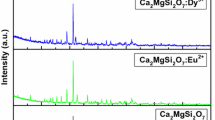Abstract
LaBO3:xDy3+ (x = 0.05 mol%, 0.1 mol%, 0.2 mol%, 0.5 mol%, 1 mol% and 2 mol%) phosphors were synthesized by solid-state reaction method. X-ray diffraction technique was used to confirm the formation of compound. Photoluminescence emission spectra shows two emission peaks at 470 nm and 575 nm when excitation wavelength is set at 352 nm. Photoluminescence intensity increases upto 1 mol % of Dy3+ and then starts decreasing. Dipole-dipole interaction is found to be responsible for concentration quenching of photoluminescence intensity. Commission Internationale de I’Eclairage (CIE) chromaticity diagram demonstrates that the phosphor emits in bluish white region of the visible spectrum. Critical energy transfer distance between dopant ions was determined. The mechanoluminescence characteristics were studied by the impact method. The peaks of both the mechanoluminescence (ML) intensity and the total ML intensity of the UV exposed phosphors increases with increasing impact velocity for 1 mol % concentration of Dy3+. The ML sensitivity of the LaBO3:Dy3+ (Dy3+ = 1 mol %) phosphor is comparable with the reported ML of various inorganic phosphors. The thermoluminescence characteristics of the samples were also investigated. Thermoluminescence glow peaks were recorded with 480 Gy, 80 Gy and 20 Gy dose of γ-irradiation from Co60 Source. TL trapping parameters were determined by Chen’s peak shape method and glow curve deconvolution method. LaBO3:Dy3+ phosphors were found to be good mechanoluminescent materials and can be used in stress sensing application.
















Similar content being viewed by others
References
Ren M, Lin JH, Dong Y et al (1999) Structure and phase transition of GdBO3. Chem Mater 11:1576–1580
Pan G, Song H, Bai X et al (2006) Novel energy-transfer route and enhanced luminescent properties in YVO4:Eu3+/YBO3:Eu3+ composite. Chem Mater 18:4526–4532
Ernest M, Levin RSR, JBM (1961) Polymorphism of ABO3 type rare earth borates. Am Mineral 46:1030–1055
Chadeyron G, El-Ghozzi M, Mahiou R et al (1997) Revised structure of the orthoborate YBO3. J Solid State Chem 128:261–266
Chadeyron G, Mahiou R, EL-Ghozzi M, et al (1997) Luminescence of the orthoborate YBO3:Eu3+. Relationship with crystal structure J Lumin 72–74:564–566
Giesber HG, Ballato J, Pennington WT, Kolis JW (2003) Synthesis and characterization of optically nonlinear and light emitting lanthanide borates. Inf Sci (Ny) 149:61–68
Hölsä J, Porcher P, Chateau C (1987) Crystal field effects in lutetium disilicates doped with Eu3+. Inorg Chim Acta 139:253–255
Lin J, Sheptyakov D, Wang Y, Allenspach P (2004) Structures and phase transition of vaterite-type rare earth orthoborates: a neutron diffraction study. Chem Mater 16:2418–2424
Pitscheider A, Kaindl R, Oeckler O, Huppertz H (2011) The crystal structure of П-ErBO3: new single-crystal data for an old problem. J Solid State Chem 184:149–153
Thakur J, Dutta DP, Bagla H, Tyagi AK (2012) Effect of host structure and concentration on the luminescence of Eu3+ and Tb3+ in borate phosphors. J Am Ceram Soc 95:696–704
Velchuri R, Kumar BV, Devi VR et al (2011) Preparation and characterization of rare earth orthoborates, LnBO3 (Ln = Tb, La, Pr, Nd, Sm, Eu, Gd, Dy, Y) and LaBO3:Gd, Tb, Eu by metathesis reaction: ESR of LaBO3:Gd and luminescence of LaBO3:Tb, Eu. Mater Res Bull 46:1219–1226
Rai RK, Upadhyay AK, Kher RS, Dhoble SJ (2012) Mechanoluminescence, thermoluminescence and photoluminescence studies on Al2O3:Tb phosphors. J Lumin 132:210–214
Botterman J, Eeckhout K Van Den, Baere I De, et al (2012) Mechanoluminescence in BaSi2O2N2:Eu. Acta Mater 60:5494–5500
Rahimi MR, Yun GJ, Doll GL, Choi J-S (2013) Effects of persistent luminescence decay on mechanoluminescence phenomena of SrAl2O4:Eu2+, Dy3+ materials. Opt Lett 38:4134–4137
Shrivastava R, Kaur J (2015) Characterisation and mechanoluminescence studies of Sr2MgSi2O7: Eu2+, Dy3+. J Radiat Res Appl Sci 8:201–207
Zhao H, Chai X, Wang X, et al (2016) Mechanoluminescence in (Sr,Ca,Ba)2SnO4:Sm3+,La3+ ceramics. J Alloys Compd 656:94–97
Gi-woo K, Min-young C, Ji-sik K (2016) Frequency response analysis of mechanoluminescence in ZnS:cu for non-contact torque sensors. Sensors Actuators A Phys 240:23–30
West AR (2003) Solid state chemistry and its applications. John Willey and Sons
Sajan SJ, Gopakumar N, Anjana PS, Madhukumar K (2016) Synthesis, characterization and mechanoluminescence of europium doped ZnxBa(1-x)Al2O4 (x = 0, 0.4, 0.5, 0.6, 0.8, 1.0) phosphor. J Lumin 174:11–16. doi:10.1016/j.jlumin.2016.01.024
Momma K, Izumi F (2011) VESTA 3 for three-dimensional visualization of crystal, volumetric and morphology data. J Appl Crystallogr 44:1272–1276
Nair GB, Dhoble SJ (2015) Highly enterprising calcium zirconium phosphate [CaZr4(PO4)6 :Dy3+, Ce3+ ] phosphor for white light emission. RSC Adv 5:49235–49247
Yang Z, Dong H, Liang X et al (2014) Preparation and fluorescence properties of color tunable phosphors Ca3Y2(Si3O9)2:Dy3+. Dalton Trans 43:11474–11477
Dutta S, Som S, Sharma SK (2013) Luminescence and photometric characterization of K(+) compensated CaMoO4:Dy(3+) nanophosphors. Dalton Trans 9654–9661
Blasse G (1968) Energy transfer in oxidic phosphors. Phys Lett A 28:444–445
Dexter DL, Schulman JH (1954) Theory of concentration quenching in inorganic phosphors. J Chem Phys 22:1063
Geng W, Zhu G, Shi Y, Wang Y (2014) Luminescent characteristics of Dy3+ doped calcium zirconium phosphate CaZr4(PO4)6(CZP) phosphor for warm-white LEDs. J Lumin 155:205–209
Chandra VK, Chandra BP (2011) Suitable materials for elastico mechanoluminescence-based stress sensors. Opt Mater (Amst) 34:45–58
Dutta S, Som S, Priya J, Sharma SK (2013) Band gap, CIE and trap depth parameters of rare earth molybdate phosphors for optoelectronic applications. Solid State Sci 18:114–122
Chen R (1969) Glow curves with general order kinetics. J Electrochem Soc 116:1254–1257
Kitis G, Gomez-Ros JM, Tuyn JWN (1998) Thermoluminescence glow-curve deconvolution functions for first, second and general orders of kinetics. J Phys D Appl Phys 31:2636–2641
Acknowledgments
One of the authors, Smt.Renu Nayar is thankful to UGC for awarding Minor Research Project, approval Letter No. and Date: No F:No MS-133/201002/XII/14-15/CRO-97 dated 7-7-2015.
Author information
Authors and Affiliations
Corresponding author
Rights and permissions
About this article
Cite this article
Nayar, R., Tamboli, S., Sahu, A.K. et al. Synthesis and Luminescence Characterization of LaBO3:Dy3+ Phosphor for Stress Sensing Application. J Fluoresc 27, 251–261 (2017). https://doi.org/10.1007/s10895-016-1952-7
Received:
Accepted:
Published:
Issue Date:
DOI: https://doi.org/10.1007/s10895-016-1952-7




